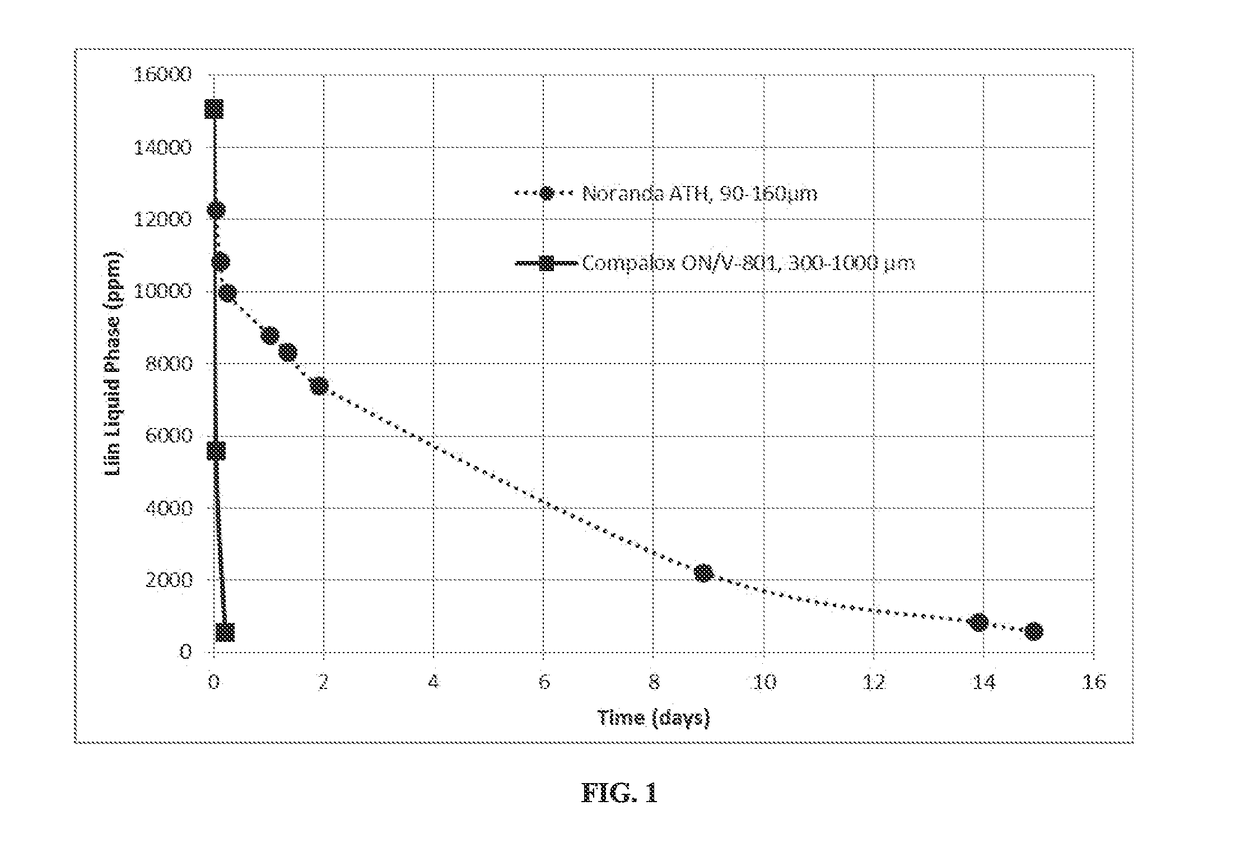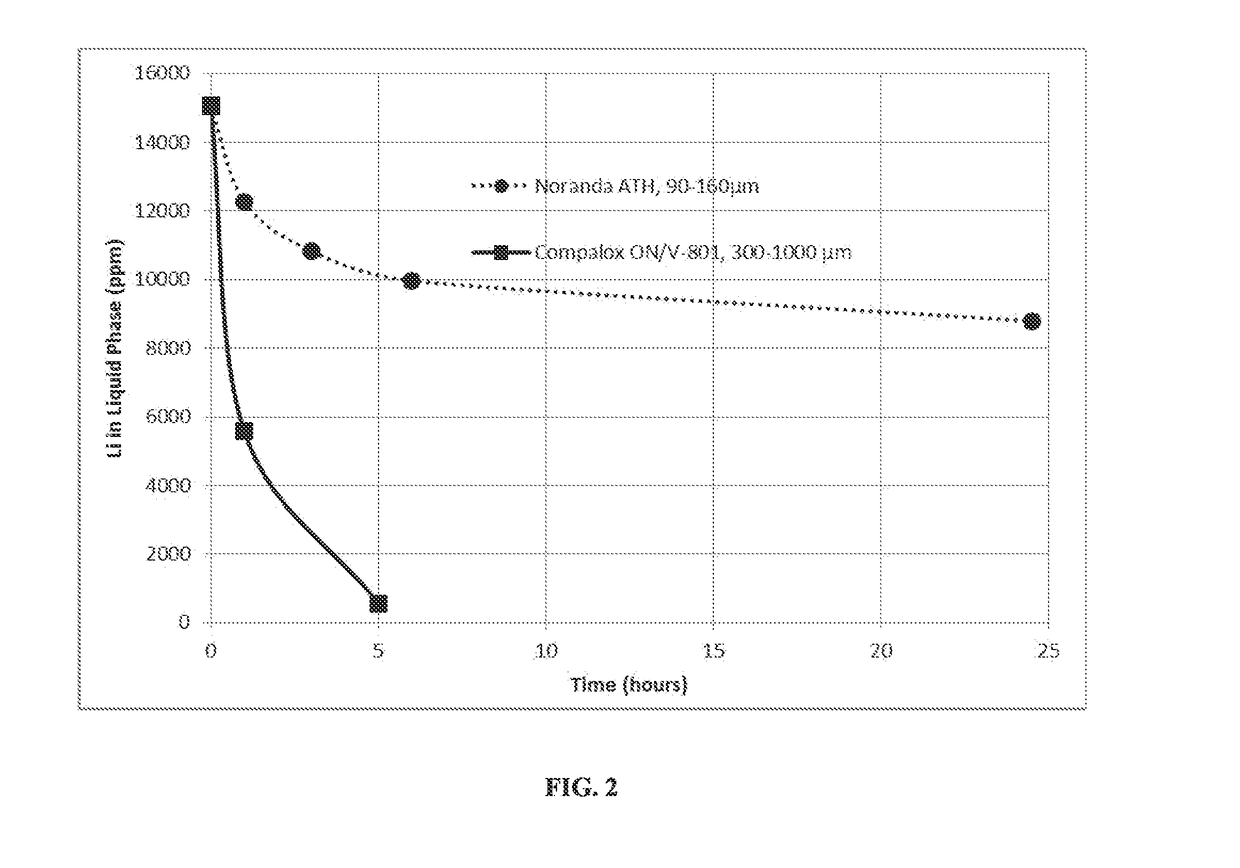Sorbents for Recovery of Lithium Values from Brines
a technology of lithium value and sorbent, which is applied in the field of lithium recovery, can solve the problems of shortening the useful life of the sorbent, and achieve the effects of improving and economizing the process of sorbent preparation, low fine amount, and structural strength
- Summary
- Abstract
- Description
- Claims
- Application Information
AI Technical Summary
Benefits of technology
Problems solved by technology
Method used
Image
Examples
example 1
[0032]In this example, compressed ATH is reacted with LiCl / caustic solution to produce a sorbent. The molar ratio of LiCl:NaOH:ATH=0.5:0.5:1 molar ratio, and 9.5% LiCl.
[0033]A 234 g (3.0 mol) portion of Compalox ON / V-801 was reacted with 670 g of a solution containing 9.5 wt % LiCl (1.5 mol) and 9.0 wt % NaOH (1.5 mol) in a 1 liter plastic bottle which was placed in an oven at 70° C. After 5 hours, the content was filtered. The filtrate contained 2079 ppm Li and the wet solids contained 2.29% Li and 19.75 wt % Al (0.45 lithium to aluminum molar ratio). The particle size data of the solids is shown in Table 1.
example 2
[0034]In this example, compressed ATH is reacted with LiCl / caustic solution to produce a sorbent. The molar ratio of LiCl:NaOH:ATH=0.5:0.4:1 and 8.0 wt % LiCl.
[0035]A 546 g (7.0 mol) portion of Compalox ON / V-801 was reacted with 1855 g of a solution containing 8.0 wt % LiCl (3.5 mol) and 6.0 wt % NaOH (2.8 mol) in two 1-liter plastic bottles placed in an oven at 70° C. After 24 hours, the combined contents of the bottles was filtered. The filtrate contained 1710 ppm Li and the wet solids (818 g) contained 2.69% Li and 23.25 wt % Al (0.45 lithium to aluminum molar ratio). The particle size data of the solids is shown in Table 1.
example 3
[0036]In this example, compressed ATH is reacted with LiCl / caustic solution to produce a sorbent. The molar ratio of NaCl, LiCl:NaOH:ATH=0.55:0.4:1, and 7.0% LiCl.
[0037]A 246 g (3.15 mol) portion of Compalox ON / V-801 was reacted with 1049 g solution containing 7.0 wt % LiCl (1.73 mol), 4.8 wt % NaOH (1.26 mol), and 7.0% NaCl in a 1 liter plastic bottle placed in an oven at 70° C. After 50 hours, the content was filtered. The filtrate contained 1860 ppm Li and the wet solids contained 2.74% Li and 22.8 wt % Al (0.47 lithium to aluminum molar ratio). The particle size data of the solids is shown in Table 1.
TABLE 1ParticleON / V-801LiX•2Al(OH)3LiX•2Al(OH)3LiX•2Al(OH)3SizeBCAl(OH)3Example 1Example 2Example 32.64.61.31.4(%)D10 (um)388165310306D50 (um)594346583581D90 (um)831580892886BC = Beckman-Coalter laser diffraction particle size analyzer
PUM
| Property | Measurement | Unit |
|---|---|---|
| molar ratio | aaaaa | aaaaa |
| particle size | aaaaa | aaaaa |
| molar ratio | aaaaa | aaaaa |
Abstract
Description
Claims
Application Information
 Login to View More
Login to View More - R&D
- Intellectual Property
- Life Sciences
- Materials
- Tech Scout
- Unparalleled Data Quality
- Higher Quality Content
- 60% Fewer Hallucinations
Browse by: Latest US Patents, China's latest patents, Technical Efficacy Thesaurus, Application Domain, Technology Topic, Popular Technical Reports.
© 2025 PatSnap. All rights reserved.Legal|Privacy policy|Modern Slavery Act Transparency Statement|Sitemap|About US| Contact US: help@patsnap.com



